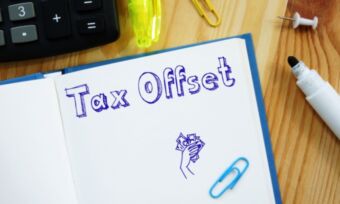What investing in shares and ETFs means for your taxes

If you have invested in shares or ETFs for the first time, here is a look at some of the issues to consider when it comes to tax time.
After last year’s bumper increase in share values, markets have spent much of 2022 treading water (at best). Nevertheless, this has been an opportunity for many Australians to get into the share market in order to chase future growth. If so, you need to fully understand the tax implications that can arise.
Here’s my guide to the key things you need to understand about shares and tax.
How dividends are taxed
The most common way for companies to pay returns to shareholders is by way of a cash dividend. Dividends are paid out of profits which have already been subject to Australian company tax which is currently 30% (or 25% for small companies). Recognising that it would be unfair if shareholders were taxed again on the same profits, shareholders receive a rebate for the tax paid by the company on profits distributed as dividends.
These dividends are described as being ‘franked’ and have a franking credit (also known as an imputation credit) attached to them representing the tax the company has already paid.
The shareholder who receives a dividend is entitled to a credit for tax the company has paid. If the shareholder’s top tax rate is less than 30% (or 25% where the paying company is a small company), the ATO will, under current rules, refund the difference.
Hypothetical example
The taxpayer holds 1,000 shares in ABC Pty Ltd.
ABC Pty Ltd makes a profit of $5 per share. It pays 30% tax on that profit which is $1.50 per share, leaving $3.50 per share. ABC Pty Ltd decides to retain 50% of the profits within the business and to pay shareholders the remaining $1.75 as a fully franked dividend. Shareholders receive this with a 30% imputation credit which isn’t physically received but which must be declared in the shareholder’s tax return as income. This can then potentially be claimed back as a tax refund.
The taxpayer therefore receives $2,500 taxable income from ABC Pty Ltd, being $1,750 dividend income and $750 franking credit, as follows:
How different investors may be taxed on dividends
| Investor 1 | Investor 2 | Investor 3 | Investor 4 | |
|---|---|---|---|---|
| Tax rate | 0% | 15% | 30% | 45% |
| Dividend | $1,750 | $1,750 | $1,750 | $1,750 |
| Imputation credit | $750 | $750 | $750 | $750 |
| Taxable income | $2,500 | $2,500 | $2,500 | $2,500 |
| Gross tax payable | $0.00 | $375 | $750 | $1,125 |
| Franking credit rebate | $750 | $750 | $750 | $750 |
| Tax payable/ (refundable) | (750) | ($375) | $0.00 | $375 |
| After tax income | $2,500 | $2,125 | $1,750 | $1,375 |
The table above shows what this may mean for different investors with different tax rates. As you can see investors 1 and 2 both receive refunds of tax related to the dividends.
Investor 1 might be a super fund in the pension phase which doesn’t have to pay tax at all and which uses the franking credit refund to fund pension payments. Alternatively, it could be an individual (perhaps a retired person) with no other income other than the dividends on these shares.
Investor 2 might be a self-managed super fund in the accumulation phase which uses the excess franking credit rebate to offset the 15% contributions tax.
Investor 3 would typically be a ‘middle income’ individual who does not have to pay any extra tax despite having received $1,750 in income.
Investor 4 would be a higher income earner who has to pay some tax on the $1,750 dividend but has reduced their tax rate on this income considerably due to the franking credits.
What happens when I sell my shares?
When you dispose of shares, assuming you are an investor, not a trader (see below), you will normally have to pay capital gains tax (CGT) on any profits. Any shares acquired before 20 September 1985 are not subject to CGT.
CGT taxes any increase in value from the time the share was acquired.
Your capital gain is worked out like this:
- Deduct the cost base from the sale proceeds. The cost base is the price you paid for the share plus incidental costs.
- Next, take away any capital losses.
- Then discount the gain. Individuals are entitled to a 50% discount. The asset must have been held for 12 months or more for the discount to be available.
- The resulting figure is your net capital gain. This is subject to tax at your marginal rate.
Sometimes the proceeds and cost base of the asset are not what was actually paid and/or received, but rather, the market value of the asset. This is typically to prevent people from minimising their tax by, say, selling the asset to a relative for a low price or gifting it for free.
Hypothetical example
Kerry sold some shares on the open market in March 2022 for $10,000. She acquired the shares in December 2005 for $5,000. She has brought forward capital losses of $2,000. Her gain is calculated as follows:
| Sale proceeds | $10,000 |
| Cost base | ($5,000) |
| Gross capital gain | $5,000 |
| Less capital losses brought forward | ($2,000) |
| $3,000 | |
| Discount @50% | ($1,500) |
| Net capital gain | $1,500 |
If your sale proceeds are less than your cost base, you will make a capital loss. These losses can be offset against capital gains arising in the same year and to the extent they are not used up, they can be carried forward indefinitely until capital gains arise to absorb them. Capital losses can only be offset against capital gains, they can’t be offset against any other form of income.
What if I trade shares as a business activity?
If you dabble in buying and selling shares regularly, are you a share investor or a share trader, and what difference does it make to your taxes? A share investor is someone who buys shares to hold onto long term, benefiting from the growth in value of the shares. Any profits or losses you make from selling your shares will be subject to CGT as above. Most people who buy and sell shares are regarded as investors by the Australian Taxation Office (ATO), irrespective of how the investors see themselves. A share trader is someone who buys and sells shares purely for short-term profits. Signs that you’re a trader include:
- Lots of transactions
- A clear profit-making intent
- You run your activities in a business-like manner (for example, a large investment of capital, a well-developed business plan, extensive research and properly maintained books and records).
Someone who buys and sells shares as part of a business will treat those shares as trading stock, and gains or losses on them will be treated as ordinary income rather than capital gains. The key tax advantage for a trader is that losses can potentially be offset against other income (subject to certain anti-avoidance provisions).
What records should I keep?
You need to keep records to substantiate your activities. In practice, that means you’ll need to keep:
- Your acquisition and disposal statements (your ‘buy’ and ‘sell’ contracts). Keep these records for five years from the date you dispose of your shares.
- Your dividend statements. Keep these records for five years from 31 October or, if you lodge later, for five years from the date you lodge your tax return. Often, dividend information is automatically provided by the paying company straight to the ATO so you may see it pre-filled in your tax return. Don’t assume that this information is correct because mistakes can be made so be sure to cross reference pre-filled information with your own source documents.
- Invoices and/or receipts for expenses.
How are ETFs taxed?
At its simplest, an exchange traded fund (ETF) is a ‘basket’ of shares, rolled-up into one security. For those looking to diversify into many different shares but without the time or inclination to manage each share purchase individually, investing into an ETF can be a convenient way to spread risk and to get access to stocks that the fund manager thinks will be high-performing. However, whilst investing in an ETF might look similar to an investment into an individual share, the tax implications are very different.
Basically, an ETF takes the form of a trust and the return paid by an ETF is treated like a distribution from the trust. However, that return will incorporate many different components, such as dividends, franking credits, interest, foreign income and capital gains. Each of those individual elements then needs to be split out by you and entered into the correct boxes on your tax return. The potential for mistakes is considerable.
Fortunately, most ETF providers give investors a year-end tax statement, which breaks down the total distribution by the various elements and often contains instructions on which specific boxes to complete on your tax return. Make sure you look out for (and keep) your annual tax statement because without it, completing your tax return accurately can be almost impossible.
Dealing with the tax implications of shares and ETFs can be very complex. Many investors use a tax agent to ensure that their return is completed accurately and it can make sense to take tax advice throughout all stages of your investment journey, from the initial investment right through to the sale of your portfolio.
Cover image source: Bychykhin Olexandr /Shutterstock.com
 About Mark Chapman
About Mark Chapman
Mark Chapman is Director of Tax Communications at H&R Block and is a regular commentator on tax matters for a variety of Australian broadcast and print media outlets, including; Money Magazine, My Business magazine, The Australian Financial Review, The Daily Telegraph, The Age and The Business Spectator. Mark is an author, Chartered Accountant, CPA and Chartered Tax Adviser and holds a Masters of Tax Law from the University of New South Wales. Follow him on LinkedIn.
This article was reviewed by our Editorial Campaigns Manager Maria Bekiaris and Sub Editor Jacqueline Belesky before it was updated, as part of our fact-checking process.






